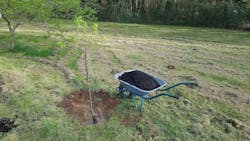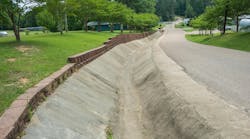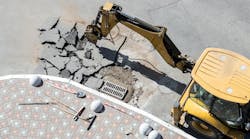Closing the loop: Sustainable stormwater management using biochars
As communities across the country race to adapt to heavier storms, rising temperatures, and mounting waste challenges, one material is quietly redefining what sustainable infrastructure can be: biochar.
Once viewed primarily as a soil amendment, biochar is now recognized as a high-performance filtration and regenerative medium for green stormwater infrastructure (GSI) delivering measurable improvements in filtration, infiltration and pollutant removal while locking away carbon and diverting waste from landfills.
From waste to resource
Biochars are produced by heating organic matter such as wood, crop residues or manures under limited oxygen through pyrolysis or gasification —processes that convert biomass into stable carbon-rich materials while releasing renewable gases or oils usable for energy. The result is a porous, carbon-dense material that acts as both sponge and molecular sieve, adsorbing nutrients, metals, hydrocarbons, and even emerging contaminants such as PFAS and microplastics.
In retrofit stormwater systems, biochar blends, often paired with compost, are being used in flow-through swales, modular bioretention, and infiltration filters. Such systems not only manage runoff but also capture legacy pollutants from historically industrialized soils. Each ton of biochar represents captured carbon and the beneficial reuse of avoided waste streams such as food waste, crop residues or biosolids.
Circular economy in practice
Traditional stormwater management is focused on collecting and conveying runoff. Green infrastructure flipped that paradigm by infiltrating and filtering water close to where it falls. Biochar goes further, embedding circularity and higher treatment performance into GSI design and maintenance.
Different feedstocks yield biochars with unique characteristics: wood-based biochars offer structural stability, which are great for soil aeration and drainage; manure- and food-waste-based biochars provide minerals and high cation exchange capacity (CEC) ideal for toxics and metal adsorption; and crop-residue or invasive-species chars add silica that improves conductivity and binding. When activated and blended properly, biochars can be tuned for specific pollutants, from nutrients and metals to PFAS and hydrocarbons. Durable and permeable, they extend filter life, reduce clogging, and lower maintenance costs. Local production also strengthens community-based circular economies by converting regional biomass wastes into high-value filtration media and green jobs.
Carbon and nutrient credits: Demonstrating the value
The performance of biochars can translate into measurable value through carbon and nutrient credit markets. Biochars with low hydrogen-to-carbon ratios (H/C < 0.7) and long-term soil stability may earn carbon removal credits based on verified carbon content and permanence.
In recent markets, carbon credit prices for certified biochars have ranged from roughly $100 to $250 per ton of CO₂e removed. Last year, one U.S.-based engineered manure biochar — the only manure-derived biochar verified and sold on the carbon credit market— achieved a sale price of about $180 per ton of CO₂e, illustrating the growing demand for durable carbon removal solutions.
Similarly, in nutrient trading programs, such as those in the Chesapeake Bay and Great Lakes regions, manure-based biochars can provide significant nutrient reductions at lower cost. A 1,000-ton installation of high-CEC biochar derived from manures or mixed organics could remove more than 300,000 pounds of nitrogen annually, potentially generating nutrient credits valued between $2 and $10 per pound of nitrogen removed. These examples show how biochar-enhanced stormwater systems can be both environmentally and economically regenerative.
Beyond water quality, capture & reuse: A circular future for sustainable stormwater management
Beyond pollutant removal, biochar delivers lasting ecosystem and community gains: long-term carbon sequestration, improved soil structure and drought tolerance, enhanced microbial and biological diversity, and cleaner, greener spaces that support local resilience and workforce opportunities.
By transforming two challenges, polluted runoff and organic waste, into a single regenerative resource, biochar dissolves the traditional divide between waste and water management, which is a great example of how stormwater fits into the Circular Water Economy (CWE) paradigm. This is the basis of an ongoing partnership between the National Municipal Stormwater Alliance (NMSA) and the Water Environment Federation (WEF) who are collaborating on a document articulating the many ways stormwater can deliver on CWE principles. In addition, a forthcoming National Stormwater Biochar Community of Practice will unite practitioners, researchers, and policymakers to scale innovation, develop standards, and accelerate adoption nationwide.
High-performance, circular stormwater systems are not a vision for the future — they are here now. With biochar, we are not just managing stormwater; we are beneficially transforming waste, restoring soils, reducing emissions, and redefining sustainable infrastructure for generations to come.
About the Author
Seth Brown
Seth Brown has over 25 years of experience in the water sector and is the Principal and Founder of Storm and Stream Solutions, LLC, a consulting firm providing a range of services from policy and alternative project delivery analysis in the stormwater sector to facilitation and training services focused on stormwater topics. He was the Director of Stormwater Programs at the Water Environment Federation from 2010-2015 and is currently the Executive Director of the National Municipal Stormwater Alliance, which is a 501.c.3 representing stormwater-focused organizations in 24 states across 9 of the 10 U.S. EPA regions with a network that is comprised of over 4,000 MS4s.
Seth has a Ph.D. in civil engineering from George Mason University with a research focus on socio-economic modeling of incentive-based investments of green stormwater infrastructure on private properties. He leads courses in Green Infrastructure and Innovative Water Partnerships at Virginia Tech and the University of Maryland at Eastern Shore and is a licensed professional engineer in the state of Maryland.


